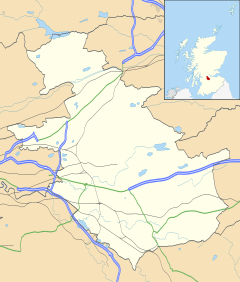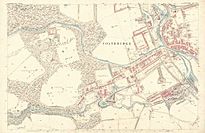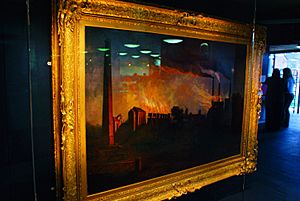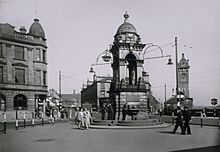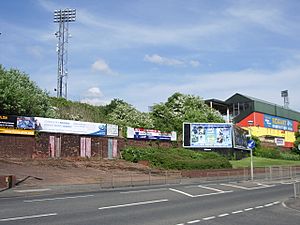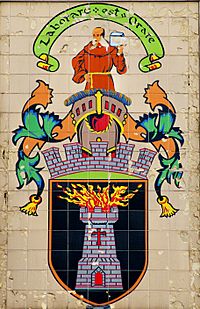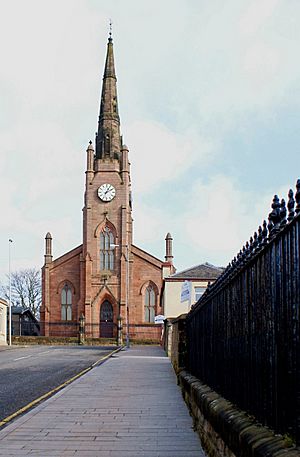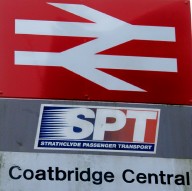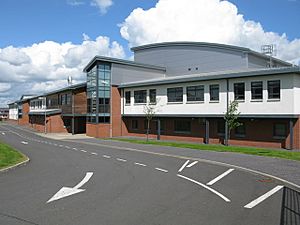Coatbridge facts for kids
Quick facts for kids Coatbridge
|
|
|---|---|
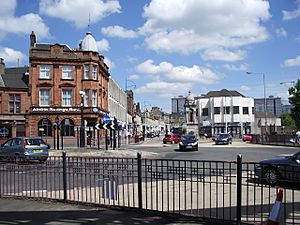 The Fountain at Bank Street |
|
| Area | 6.818 sq mi (17.66 km2) |
| Population | 43,950 (2020) |
| • Density | 6,038/sq mi (2,331/km2) |
| OS grid reference | NS730651 |
| • Edinburgh | 33 mi (53 km) ENE |
| • London | 341 mi (549 km) SSE |
| Council area | |
| Lieutenancy area | |
| Country | Scotland |
| Sovereign state | United Kingdom |
| Post town | COATBRIDGE |
| Postcode district | ML5 |
| Dialling code | 01236 |
| Police | Strathclyde |
| Fire | Strathclyde |
| Ambulance | Scottish |
| EU Parliament | Scotland |
| UK Parliament |
|
| Scottish Parliament |
|
Coatbridge (Scots: Cotbrig or Coatbrig, locally /ˌkoʊtˈbrɪdʒ/) is a town in North Lanarkshire, Scotland, about 8+1⁄2 miles (14 kilometres) east of Glasgow city centre, set in the central Lowlands. Along with neighbouring town Airdrie, Coatbridge forms the area known as the Monklands (population approximately 90,000 including outlying settlements), often considered to be part of the Greater Glasgow urban area – although officially they have not been included in population figures since 2016 due to small gaps between the Monklands and Glasgow built-up areas.
In the last years of the 18th century, the area developed from a loose collection of hamlets into the town of Coatbridge. The town's development and growth have been intimately connected with the technological advances of the Industrial Revolution, and in particular with the hot blast process. Coatbridge was a major Scottish centre for iron works and coal mining during the 19th century and was then described as 'the industrial heartland of Scotland' and the 'Iron Burgh'.
Coatbridge also had a notorious reputation for air pollution and the worst excesses of industry. However, by the 1920s, coal seams were exhausted and the iron industry in Coatbridge was in rapid decline. After the Great Depression, the Gartsherrie ironwork was the last remaining iron works in the town. One publication has commented that in modern-day Coatbridge "coal, iron and steel have all been consigned to the heritage scrap heap".
Contents
History
There are various explanations for the origin of the town's name. The place name Coatbridge first appears on a number of 19th century maps, although Roy's 1750 map notes 'Cottbrig' as a hamlet in the Old Monkland area. Older Scots 'Cot(t)' (cottage) and 'brig' (bridge). (This reflected in the way locals refer to the town or its centre as 'The Brig': "I'm just going up the Brig.") One source states 'Coatbridge' is either derived from the Middle English 'cote', (cottage) or from the Old Welsh 'coed' meaning 'wood'.
An alternative explanation is that from around the 13th century the local area was owned by the Colt family, sometimes known as Coats, and their estate generated place-names such as Coatbridge, Coatdyke, Coathill and Coatbank. Drummond and Smith suggest the name derives from the granting of land to Ranulphus le Colt around the time of the 12th century. However, Early Scots had vocalized to by the 16th century and subsequently diphthongised to in Modern Scots, so that 'Colt' would have become 'Cowt' rather than 'Coat'. Modern Scots 'Cot' (cottage) is realized.
Early history: from Bronze Age to Middle Ages
Settlement of the Coatbridge area dates back 3000 years to the Mesolithic Age. A circle of Bronze Age stone coffins was found on the Drumpellier estate in 1852. A number of other Bronze Age urns and relics have been found in Coatbridge. An Iron Age wood and thatch crannóg dwelling was sited in the Loch at the present day Drumpellier Country Park. Dependent upon the water level in the loch, the remains can still be seen today.
Roman coins have been unearthed in Coatbridge, and there are the remains of a Roman road on the fringes of the town near the M8 motorway.
Middle Ages to late 18th century
The 'Monklands' area inherited its name after the area was granted to the Cistercian monks of Newbattle Abbey by King Malcolm IV in 1162. 1n 1323 the Monklands name appeared for the first time on Stewards' charter. The Monks mined coal and farmed the land until the time of the reformation when the land was taken from them and given to private landowners. In 1641 the parish of Monklands was divided between New Monkland (present day Airdrie) and Old Monkland (present day Coatbridge). In 1745 Bonnie Prince Charlie's Jacobite army seized Coatbridge from government troops on their march to Edinburgh in an action described as the 'Canter of Coatbridge'. Coatbridge was described in the 1799 Statistical Account as an 'immense garden' with 'extensive orchards', 'luxurious crops' where 'rivers abound with salmon'.
19th century
The Monkland Canal was constructed at the end of the 18th century initially to transport coal to Glasgow from the rich local deposits. The invention of the hot blast furnace process in 1828 meant that Coatbridge's ironstone deposits could be exploited to the maximum by the canal link and hot blast process. The new advances meant that iron could be produced with two thirds less fuel. Summerlee Iron Works was one of the first iron works to use this technology. By the mid 19th century there were numerous hot blast furnaces in operation in Coatbridge.
The prosperous industry which had sprung up around the new iron industry required vast numbers of largely unskilled workers to mine ironstone and work in the blast furnace plants. Coatbridge therefore became a popular destination for vast numbers of Irish (especially from County Donegal in Ulster) arriving in Scotland. The iron bars and plates produced in Coatbridge iron works were the raw materials needed throughout the British Empire for railways, construction, bridge building and shipbuilding. One example of uses Coatbridge' iron was put to included armour plating for British ships fighting in the Crimean War.
Over the course of the following forty years the population of Coatbridge grew by 600%. The character of the Coatbridge area changed from a rural, Presbyterian landscape of small hamlets and farmhouses into a crowded, polluted, Irish Catholic industrial town.
One contemporary observer at this time noted that Coatbridge is 'not famous for its sylvan beauties of its charming scenery' and 'offers the visitor no inducements to loiter long'. However, 'a visit to the large Gartsherrie works is one of the sights of a lifetime'.
Most of the town's population lived in tight rows of terraced houses built under the shadow of the iron works. These homes were often owned by their employers. Living conditions for most were appalling, tuberculosis was rife.
For a fortunate few though fortunes could be won 'with a rapidity only equalled by the princely gains of some of the adventurers who accompanied Pizarro to Peru', noted one observer. Among the most notable success stories were the six sons of Coatbridge farmer Alexander Baird. The Baird family had become involved in coal mining but opened an iron foundry in order to exploit the new hot blast process of iron smelting invented by James Beaumont Neilson. The Baird's subsequently constructed numerous iron foundries in Coatbridge including the famous Gartsherrie iron works. The waste heap or 'bing' from the Baird's Gartsherrie works was said to be as large as the great pyramid in Egypt. One son, James Baird, was responsible for erecting sixteen blast-furnaces in Coatbridge between 1830 and 1842. Each of the six sons of Alexander Baird was reputed to have become a millionaire.

In the 19th century, the Baird family wielded a pervasive influence over Coatbridge. They were responsible for the design of the lay out of present-day Coatbridge town centre. The land for the Town Hall and the land which later came to form Dunbeth Park was given to the town by the Bairds. Gartsherrie church was built by the Baird family. The Bairds donated the site on the Main Street for the erection of St. Patrick's Catholic Church. However, they also used patronage of the Orange Order to try and undermine the local trade union movement.
20th/21st centuries
By 1885, the once plentiful Monklands ironstone deposits had been largely exhausted. It became increasing expensive to produce iron in Coatbridge as raw materials had to be imported from as far afield as Spain. The growth of the steel industry (in nearby Motherwell) had also led to a start of a decline in demand for the pig iron Coatbridge produced. Living conditions remained grim.
George Orwell's book The Road to Wigan Pier was illustrated by a photograph of homes in the Rosehall area of Coatbridge. In 1934 there was an exodus to Corby in England when the local Union Plant relocated. This had the effect of a hammer blow impact on the town's iron industry and ushered in the end of serious iron production. The decline of the Clydeside shipbuilding industry in the 1950s meant the demand for iron finally collapsed. A legacy of 'devastating' unemployment, appalling housing conditions and some of the worst overcrowding in Scotland left its stamp on the Coatbridge of the early 1930s. As late as 1936 Coatbridge was the most overcrowded place in Scotland.
In the 1930s and 1950s however massive programmes of state-sponsored house building saw thousands of new homes built in Coatbridge and some of the worst examples of slum housing were cleared away. By the early 1980s 85% of homes in Coatbridge were part of local authority housing stock. The last of the blast furnaces, William Baird's famous Gartsherrie works, closed in 1967.
Since the 1970s there have been various initiatives to attempt to regenerate Coatbridge. Urban Aid grants, European Union grants and, more recently, Social Inclusion Partnership's have attempted to breathe new life into Coatbridge. Despite these efforts the town's population has continued to fall and in recent years the town has been dubbed the 'most dismal in Scotland'.
Geography
 |
Gartcosh | Glenboig, Cumbernauld | Glenmavis |  |
| Glasgow | Airdrie, Edinburgh | |||
| Uddingston | Bellshill | Motherwell, Calderbank |
At 55°51′44″N 4°1′46″W / 55.86222°N 4.02944°W (55.861°, -4.047°), Coatbridge is situated in Scotland's Central Lowlands. The town lies 88 metres (288 ft) above sea level, 9 miles (14.5 km) east of Glasgow, 6 miles (10 km) south of Cumbernauld and 2 miles (3 km) west of Airdrie. Although Coatbridge has no major river running through it, the North Calder Water runs east-west to the south and the now defunct Monkland Canal used to run straight through the centre of the town toward Glasgow. The canal route through Coatbridge can still be seen today. There are also several smaller burns which run through Coatbridge, most of which drain to the North Calder Water. Coatbridge has four significant public parks. Dunbeth park, West End park, Whifflet park and Drumpellier Country park. Woodend and Witchwood Loch are situated on the north-west edge of Coatbridge.
Topography
The topography of Coatbridge was an important feature in the towns development during the industrial revolution. Coatbridge rests 60 metres below the 'Slamannan plateau' which neighbouring Airdrie sits on the edge of. The low-lying flat ground of Coatbridge was a vital factor in the siting of the towns' blast furnaces and the Monkland Canal route. Although Airdrie was an already established town and had local supplies of ironstone, the Monkland Canal link did not extend into Airdrie because of its higher elevation. The Clyde Valley plan of 1949 described Coatbridge as 'situated over a flooded coalfield'. Tenement buildings in Coatbridge were not built to the same level as Glasgow tenements due to danger of local subsidence from centuries of local mining.
Geology
Dunbeth hill where the present local authority municipal buildings stand is a wedge of rock which was probably squeezed upwards by the force of two (now-extinct) fault lines. There are the remains of spreads of glacial sands along the crest of Drumpellier, the west bank of Gartsherrie Burn and along modern day Bank Street. Kirkwood, Kirkshaws and Shawhead sit on a sandstone capped ridge looking south over the Clyde Valley. The vital Coatbridge black band coal field extended from Langloan to beyond the eastern edge of the town.

Climate
Like much of the British Isles, Coatbridge experiences a temperate maritime climate with relatively cool summers and mild winters. The prevailing wind is from the west. Regular but generally light precipitation occurs throughout the year.
Sports
Coatbridge's local football team is Albion Rovers. Albion Rovers play in the Lowland Football League having been relegated from Scottish League Two following the 2022–23 season. Cliftonhill is where they play their home games. The "Wee Rovers" were founded in 1882 when two local Coatbridge clubs, Rovers and Albion, amalgamated to form the club bearing the name.
Coatbridge CC a local amateur football club founded in 1976 became Scottish Champions in 1986 and again in 1988. Coatbridge CC became the first amateur football club to win the Scottish Cup and the West of Scotland cup in the same season.
Coatbridge Bowling Club (founded 1849) celebrates its 175th anniversary in 2024 and is the oldest sports club in the town. It is situated in Bowling Street, in the Blairhill area of Coatbridge.
The Coatbridge Indoor bowling club hosted the World Indoor Bowls Championships from 1979 until 1987.
Drumpellier Cricket Club has been in continuous existence for over 150 years and the club has a ground in the Drumpellier area.
Greyhound and speedway racing also took part in the town, using the Albion Rovers FC ground. Greyhound Racing began on 11 December 1931 and lasted until 1986. The Edinburgh Monarchs rode there in 1968–69 (as the Coatbridge Monarchs) after losing their track at Meadowbank Stadium to the developers for the 1970 Commonwealth Games. Glasgow Tigers moved from Hampden Park to Coatbridge in 1973, and stayed there until June 1977, when they were forced out by the greyhound racing.
Coatbridge was the home of former boxer Bert Gilroy, Scotland's longest-reigning champion. Coatbridge is also home to the former WBO Super-featherweight, lightweight and light-welterweight world champion Ricky Burns. Walter Donaldson, former World Snooker champion, also hailed from Coatbridge.
There are two golf courses: the municipal course bordering Drumpellier Country Park and the nearby private member's club Drumpellier Golf Course. Clare Queen, Scotland's number one female golfer on the women's European tour, is from Coatbridge.
Coatbridge has a sumo club, Clan Sumo.
Coat of arms
Coatbridge was given burgh status in 1885, and was granted a coat of arms by the Lord Lyon in 1892. The arms have a black field and on it a flaming tower to represent a blast furnace and Coatbridge's industrial tradition. The crest is a monk holding a stone in his left hand. The stone relates to the old parish of Monklands and the legend of the 'aul' Kirk stane'. The legend of the 'aul' Kirk stane' is that a pilgrim undertaking a penance from Glasgow carried a stone in the direction of Monklands. When he could carry the stone no further (or in another version of the legend, when an angel spoke to him) he laid the stone down. It was where the stone came to rest that he was to build a church. The church is the present day Old Monkland Kirk, at which the stone can still be seen.
The Latin motto 'Laborare est orare' translates as 'to work is to pray', which originates in the writings of St. Benedict and is commonly associated with the Cistercian Order whose monks came to Monklands in the 12th century.
Demography
| Coatbridge | North Lanarkshire | Scotland | |
|---|---|---|---|
| Total population | 41,170 | 321,067 | 5,062,011 |
| Foreign born | 1.3% | 1.7% | 3.8% |
| Over 75 years old | 6.1% | 5.6% | 7.1% |
| Unemployed | 5.3% | 4.5% | 4.0% |
According to the United Kingdom Census 2001, the census locality of Coatbridge had a total resident population of 41,170, or 13% of the total of North Lanarkshire. This figure, combined with an area of 6.818 square miles (17.7 km2), provides Coatbridge with a population density figure of 6,038 inhabitants per square mile (2,331/km2).
| Year | Population |
|---|---|
| 1755 | 1,813 |
| 1831 | 9,580 |
| 1851 | 27,333 |
| 1901 | 36,991 |
| 1911 | 43,286 |
| 1921 | 43,909 |
| 1931 | 43,056 |
| 1951 | 47,685 |
| 1961 | 54,262 |
| 1971 | 51,493 |
| 1981 | 48,445 |
| 2001 | 41,170 |
The median ages of males and females living in Coatbridge were 35 and 38 years respectively, compared to 37 and 39 years in the whole of Scotland. 34% were married, 6.1% were cohabiting couples, 14.7% were single parent families and 32.5% of households were made up of individuals.
The place of birth of the town's residents was as follows: 98.7% United Kingdom (including 96% from Scotland), 0.32% Republic of Ireland, 0.30% from other European Union countries, and 0.72% from elsewhere in the world. The economic activity of residents aged 16–74 was 39.3% in full-time employment, 9.4% in part-time employment, 3.6% self-employed, 5.3% unemployed, 2.5% students with jobs, 3.2% students without jobs, 13.4% retired, 5.7% looking after home or family, 12.0% permanently sick or disabled, and 5.7% economically inactive for other reasons. Compared with the average demographics of Scotland, Coatbridge has low proportions of people born outside the United Kingdom, and people over 75 years of age.
During the 19th century, Irish people began to arrive in large numbers in Coatbridge. The 1851 UK Census recorded that Irish people constituted 35.8% of the local population. A significant proportion of these immigrants were Protestant, but the majority were Catholic. By 1901 UK Census, the percentage of Irish-born people in Coatbridge had fallen to around 15%, but remained the highest of all the major towns in Scotland. In the 2001 UK Census, Irish ethnicity was recorded at just over 1%, although just over half the population claimed their religious denomination as Roman Catholicism. In 1985, 56% of the population of Coatbridge were Roman Catholic.
In 2006, Coatbridge (along with Port Glasgow and Clydebank) was identified as "the least Scottish town in Scotland" due to having the highest percentage of Irish names in the country. Reportedly more than 28% of adults in Coatbridge had names with Irish origins.
Other immigrants to Coatbridge have included in the 1880s a small number of Lithuanians. In 1905, part of a "wave" of immigrants from Monte Cassino in Italy settled in Coatbridge. A small number of Polish people had stayed in Coatbridge after a Polish tank regiment was stationed in the town during World War II.
Economy
21st century Coatbridge is the site of Scotland's inland container base; it was chosen as the site in part due to the proximity of various rail and motorway networks. Makers of PA systems and loudspeakers Tannoy Ltd. are headquartered in the town. Lees of Scotland is a local confectionery and bakery products company and are the manufacturers of the Lees Macaroon bar, and has been operating in Coatbridge since 1931. William Lawson's Scotch Whisky distillery has been located in the town since 1967. It was home to one of the first B&Q Depots, which was closed in 2006 and moved to the new retail park. The oldest family business in Coatbridge and Airdrie is funeral directors Donald McLaren Ltd, which was founded in 1912.
In terms of housing, property prices in Coatbridge have undergone rapid growth since 2000. In 2005, house prices rose by 35%, reportedly the largest such increase in Scotland.
Landmarks
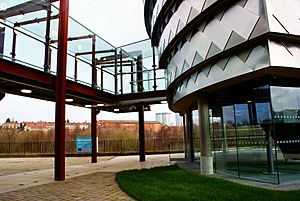
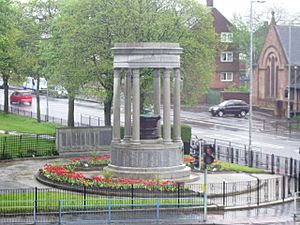
The built environment around Coatbridge's town centre is a mixture of late 19th- and early 20th-century sandstone buildings and late 20th-century precast concrete shops. The leafy Blairhill and Dunbeth conservation areas to the west and north of the town centre comprise detached, semi-detached and terraced sandstone residential buildings. The bulk of the remaining surrounding areas consist of various 20th-century local authority housing buildings. Several high-rise flats dominate the skyline. Due to the decline of industries, several private housing estates have been built on reclaimed land.
In 2007, Coatbridge was awarded Prospect architecture magazine's carbuncle award for being the 'most dismal town in Scotland'. The town was also described by Scottish comedian Frankie Boyle as 'like Bladerunner... without the special effects'.
Drumpellier Country Park is set around Lochend Loch (more commonly known to locals as 'Drumpellier Loch'). There are extensive woodlands, a visitor centre and a butterfly house. Monkland Canal runs through a section of the park.
The Time Capsule is a multi-purpose leisure centre containing a swimming pool, an adventure pool set in a prehistoric environment, an ice skating facility, sauna/steam room and a sports complex with gym halls and other facilities. The Showcase Leisure Park contains a 14-screen cinema, a 10-pin bowling complex and numerous restaurants.
Landmarks in Coatbridge include:
- Coatbridge Leisure Centre – Peter Womersley 1970s brutalist, modernist cantilevered building sited on the main road into Coatbridge
- The former Coatbridge Library – an Andrew Carnegie-sponsored 1905 pink sandstone structure. Imposing B-listed structure sited on Academy Street
- St Augustine's Church and buildings – Built in 1873 and located in the Dundyvan area. A red sandstone B-listed Rowand Anderson Gothic church
- St Andrew's Church – 1839 early Victorian Gothic church by Scott Stephen & Gale in the Whitelaw hill area. Its steeple towers over the town centre.
- Coatbridge railway bridges – The B-listed 1898 bridges span Bank Street, West Canal Street and the former Monkland Canal. The bridges underwent specialist restoration in 2009
- St Mary's Church – B-listed Gothic church in Whifflet designed by Pugin and Pugin in 1896. Contains an elaborate and ornate interior ceiling.
- The former Cattle Market Building – erected in 1896, B-listed façade of the sandstone cattle market building, facing West Canal Street and within the Blairhill and Dunbeth conservation area
- Summerlee Heritage Park 2008 extension – Spaceship style glass and metal addition to existing building by North Lanarkshire Council's in-house Design Services Team
Transport
The Monkland Canal (completed 1791) was used in the 19th and 20th century to transport coal and iron to Glasgow. The town centre section of the canal was interred in pipe between Sikeside and Blair Road in the mid-1970s. Some sections of the Monkland Canal can still be seen today between Townhead and Drumpellier. Coatbridge is adjacent to the M8 and M73 motorways. The M74 motorway is also a short drive away. The major cities of Edinburgh, Stirling and Glasgow are all within commuting distance.
Due to the number of rail lines running through Coatbridge, it was once dubbed the "Crewe of the North". There are six railway stations on the four railway lines that bisect the town: Motherwell-Cumbernauld Line; Argyle Line; Whifflet Line; and North Clyde Line. The six stations within Coatbridge and on these lines are: Blairhill; Coatbridge Central; Coatbridge Sunnyside; Coatdyke; Kirkwood; and Whifflet.
Coatbridge has had additional passenger stations, such as Langloan and Calder Station (Greenend); these stations have been closed for many years.
McGill's Buses are responsible for most of the bus services in the town, after buying out most of the smaller local companies. The buses are all in Go Zone 8 on the McGill's network. The buses link all the major neighbourhoods with the 212 continuing on to Airdrie, Plains and Caldercruix.
Neighbourhoods
The earliest map showing Coatbridge is by Timothy Pont published in Johan Blaeu's Nether warde of clyds-dail (1654). The districts of Dunpelder, Gartsherrie, Langloan, Kirkwood, Kirkshaws and Whifflet are all evident.
The present day neighbourhoods of Coatbridge are Barrowfield, Blairhill, Brownshill, Carnbroe, Cliftonhill, Cliftonville, Coatbank, Coatdyke, Cuparhead, Drumpellier, Dunbeth, Dundyvan, Espieside, Gartsherrie, Greenhill, Greenend, Kirkshaws, Kirkwood, Langloan, Old Monkland, Rosehall, Shawhead, Sikeside, Summerlee, Sunnyside, Townhead and Whifflet. Victoria Park is a relatively new area close the town centre which was built on a brownfield site once occupied by heavy industry. The Blairhill and Dunbeth neighbourhoods are part of the Blairhill and Dunbeth conservation area.
Whitelaw is the area which the town centre is in but is a term which has not been used for many years. The fountain which is situated at the town centre on the corner of Main Street and South Circular Road is officially called the Whitelaw Fountain.
Education
Coatbridge College was built as Scotland's first college in the 1860s. As Coatbridge has moved away from the traditional heavy industries the teaching focus has shifted from traditional industry courses towards commerce, care and the arts. After resisting previous mergers, it became a campus of the multi-site New College Lanarkshire in 2014.
St Ambrose High School (which opened a new building in 2013), St Andrew's High School (which opened in 2006 following a merger of the defunct Columba H.S. and St Patrick's H.S.) and Coatbridge High School (new building opened in 2008 on the site of St Patrick's previous campus – Coatbridge's old campus is now occupied by Greenhill Primary and Drumpark Primary) are the main secondary schools serving the town. The first two are Roman Catholic; it is one of few places in Scotland where the number of denominational schools is greater than non-denominational. St Ambrose was the subject of an HMI follow-up assessment visit in January 2009. Sports journalist and broadcaster Bob Crampsey was formerly headmaster of St Ambrose, prominent football referee Willie Collum taught religious education at the school in the early 2000s, and singer/television presenter Michelle McManus is among the former pupils. Rosehall H.S. was a previous school in the town, whose pupils now typically attend Coatbridge. Coatbridge also has several special needs schools including Pentland School (primary school), Portland High School, Drumpark School (now primary department only), Willowbank School (high school) and Buchanan High School.
Public services
Coatbridge forms part of the Western water and sewerage regions of Scotland. Waste management is provided by the North Lanarkshire local authority. Water supplies are provided by Scottish Water, a government-owned corporation of the Scottish Government. Coatbridge's distribution network operator for electricity is Scottish Power. Coatbridge is served by Monklands Hospital, sited on the Airdrie side of the Coatbridge/Airdrie border. The NHS board is NHS Lanarkshire. Scottish Fire and Rescue Service is the statutory fire and rescue service which operates in Coatbridge. Policing in Coatbridge is provided by the Police Service of Scotland (Lanarkshire Division). The Strathclyde Partnership for Transport, a public body in Scotland, has direct operational responsibilities, such as supporting (and in some cases running) local bus services, and managing integrated ticketing in Coatbridge and other areas from the former Strathclyde region. Transport Scotland manages the local rail network.
The local authority responsible for community-based service in Coatbridge is North Lanarkshire Council. The council provides local services related to education, social work, the environment, housing, road maintenance and leisure.
Notable people
- Cha Burns (1957–2007), guitarist with the Scottish folk band, The Silencers
- Ricky Burns, boxer, World Super Featherweight, Lightweight, Super Lightweight Champion
- Bill Carroll, radio host
- Sean Clark, former footballer
- Jock Cunningham, miner, mutineer and Republican Brigade commander during the Spanish Civil War
- Alan Frew, songwriter and lead vocalist for Canadian band Glass Tiger
- Frank Gallagher, actor (River City, Taggart, etc.) was born in Coatbridge
- Prof James Clark Gentles, first specialist in fungal diseases of the human body
- JJ Gilmour, vocalist with the Scottish folk band, The Silencers
- George Graham (footballer and football manager) played with Aston Villa, Chelsea, Arsenal, Manchester United and managed Arsenal and Tottenham Hotspur lived in Bargeddie
- Ayesha Hazarika, Baroness Hazarika, broadcaster, journalist and political commentator, and former Labour Party political adviser, grew up in Coatbridge
- Jock Kane, intelligence officer and GCHQ whistleblower
- Greg and Pat Kane, brothers that formed the 1980s band Hue and Cry, are from the Blairhill area of Coatbridge
- Mark Kerr, Scottish footballer, played for Aberdeen, and managed Ayr United
- Joe Kissock, former New Zealand international footballer
- Robert Lees, member of the Wisconsin State Senate
- Willie McDonald, footballer for Manchester United and Coventry City
- Rev William Currie McDougall, poet and subject of the Coatbridge Free Church scandal
- Gerry Maher (Jurist), Professor of Criminal Law, University of Edinburgh, attended St Patrick's High School
- Rev Dr Peter Marshall (27 May 1902 – 26 January 1949) Chaplain of the United States Senate, whose biography was the basis of the Oscar-nominated film A Man Called Peter, was born in Coatbridge
- Mark Meechan (Count Dankula), YouTuber and politician
- Mark Millar, comic book writer and creator of the Millarworld franchise
- Iain Munro (footballer) St Mirren, Hibernian, Rangers, Sunderland, Stoke and Scotland, taught at Coatbridge High School
- Hugh Murray, rugby union player
- Joseph Parker (mining engineer), born in Coatbridge
- Jamie Quinn actor and musician
- Johnny Russell, Dundee United footballer attended Coatbridge High School
- John "Jock" Stein (footballer and football manager) who led Celtic to the European Cup in 1967, the first British club to win this trophy, played for Albion Rovers
- Admiral Sir James Stirling, first governor of Western Australia
- Heather Suttie, DJ and radio presenter
- Stephen Trainer, football player
- Neil Walker (Jurist), Professor of Public Law and the Law of Nure and Nations, University of Edinburgh attended Coatbridge High School
- Tony Watt, former Celtic FC striker, scored for Celtic in win against Barcelona in 2012, now plays for Dundee United
- Stephen Welsh, football player
Twin towns
Coatbridge is twinned with:
- St. Denis, France
- Campi Bisenzio, Italy
- Gatchina, Russia
See also
 In Spanish: Coatbridge para niños
In Spanish: Coatbridge para niños


